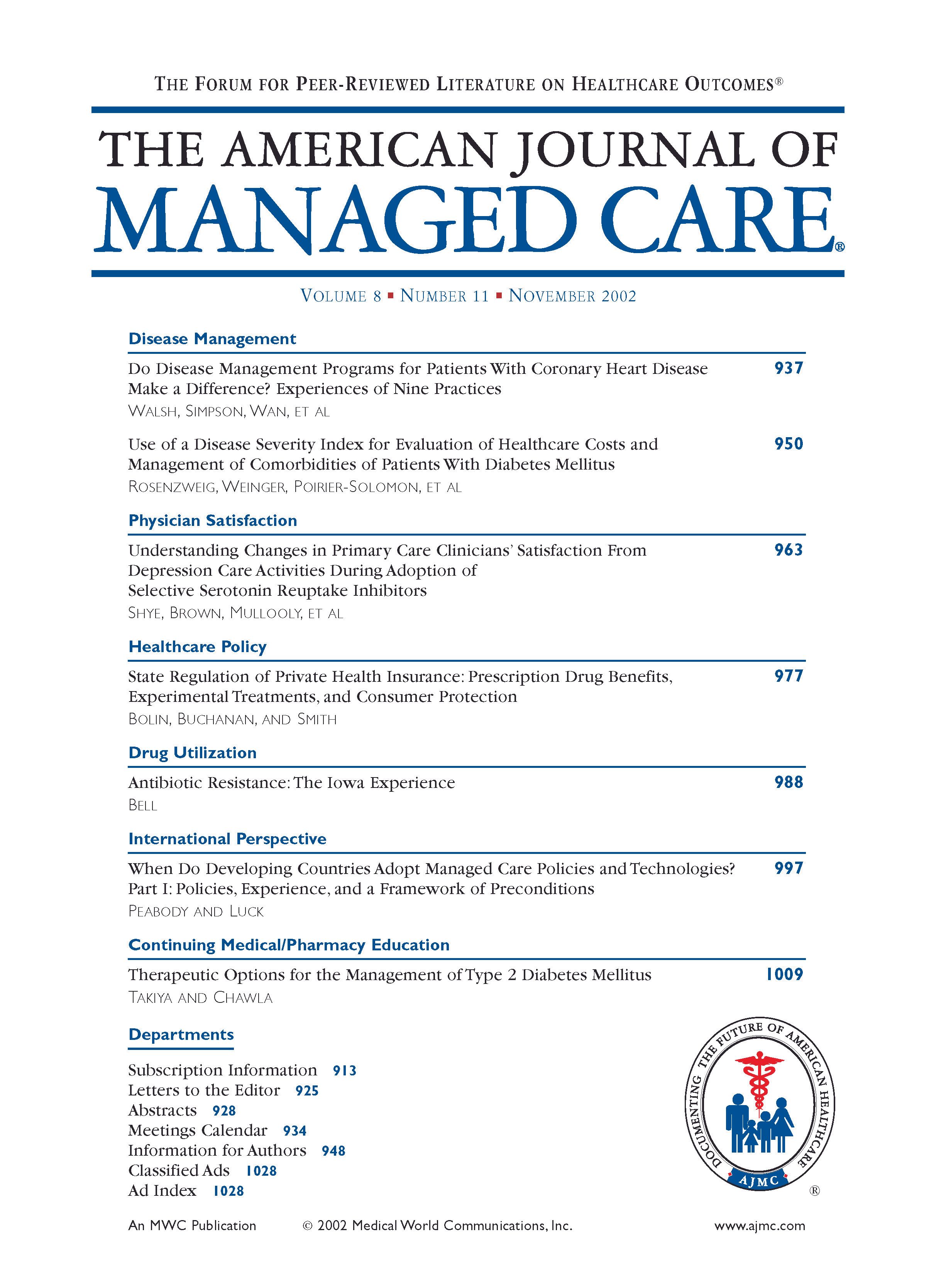- Center on Health Equity & Access
- Clinical
- Health Care Cost
- Health Care Delivery
- Insurance
- Policy
- Technology
- Value-Based Care
Mechanisms to Improve Pharmaceutical Use in Managed Care: To Study Controls, Control the Studies [Please]
Establishing a balance between increasing utilization and escalating costs of prescription pharmaceuticals is a daunting task confronting healthcare decision makers. To better deal with the unremitting tug-of-war between a seemingly endless demand for drugs and resolute payers insisting that expenditures be constrained, managed care organizations (MCOs) have developed tools to enhance quality of care, maintain enrollee and clinician satisfaction, and stem rising drug costs. Interestingly, most, if not all, of these interventions have been widely implemented before the availability of rigorous evidence supporting their effectiveness.
Decades of experience instruct us that it is a rare occasion when a medical intervention simultaneously improves clinical outcomes and reduces aggregate healthcare expenditures. (These rare exceptions are well known and are often cited in this journal.) While we patiently (and optimistically) wait for medical innovation to mirror the "better and cheaper" example of personal computers and DVD players, MCOs' control mechanisms tend to focus on either quality improvement or cost containment, given the low probability of concurrently achieving both outcomes.
Quality improvement mechanisms (eg, educational programs, guideline implementation, disease management, etc) tend to focus on increasing utilization of medical services whose benefit is rigorously established, yet remain underutilized despite the evidence supporting their use (eg, aspirin after myocardial infarction, cancer screening, immunizations, etc). In these instances, the incremental resources required to increase use are collectively viewed as "worthwhile" expenditures. In contrast, a different set of mechanisms exists to manage service utilization (eg, prior authorization, tiered copayments, step therapy, etc). While these controls may be quality driven-to minimize inappropriate and or dangerous utilization-a more common purpose is to encourage efficient use, particularly of relatively expensive therapies (eg, proton pump inhibitors). While there is little debate that physicians and payers are motivated to provide services that improve clinical outcomes, it is not feasible to provide the "best" intervention to every individual in every circumstance. Even when rigorous data support clinical advantages, additional expenditures in certain situations are not viewed as efficient (eg, COX-2 selective inhibitors for low-risk nonsteroidal anti-inflammatory drug users).
In this issue, Pearson and colleagues report a systematic review examining the effectiveness of numerous strategies to improve the quality and efficiency of medication use.1 The authors conclude that several commonly used interventions, such as guidelines with local input, academic detailing with samples, multifaceted educational outreach, and patient-specific feedback were effective in enhancing drug use. (Dissemination of educational materials alone and formulary-related interventions were for the most part ineffective.) Disease management programs (mainly in depression and diabetes) were found to yield clinical benefits. The authors conclude with the encouraging finding that the publication of high quality studies is on the rise, with a majority published since 1996.
If I were to stop here, readers could make a just accusation that this interpretation of the data is overly optimistic. To this point, the Pearson et al review reveals several concerns germane to this journal's readers and contributors. First, there was a dearth of studies (only 48 since 1966) that met the authors' prespecified criteria of high methodological quality. Second, a great majority of studies were performed in staff-, group-, and mixed-model settings; only 7 were conducted independent practice associations and network-model organizations and none in preferred provider organizations. Third, when controlled investigations were undertaken, they were limited to a small number of clinical conditions (of 36 total randomized controlled trials, 19 were in depression). Fourth, long-term assessments were lacking. Last, cost-effectiveness evaluations of pharmacy interventions-even for those that produced quality enhancements-were absent and are clearly warranted.
The tension between the demand for access to drugs and the related cost consequences is clearly palpable in numerous venues, including national and state legislatures, corporate boardrooms, senior centers, and clinicians' offices. We applaud MCO efforts to develop strategies that aim to enhance quality and/or constrain cost growth. However, as "controls" are put into practice, "controlled" evaluations to quantify their value should accompany their implementation. To this end, we strongly encourage the submission of controlled studies of managed care mechanisms (not limited to pharmacy) aimed to improve quality of care. While randomized trials are preferred, pre/post studies with a nonrandomized control, and interrupted time series with a comparison group are also acceptable. We are equally interested in publishing controlled studies examining the implications of mechanisms implemented to manage utilization, particularly those that report on how these strategies impact clinical outcomes (including missed opportunities for benefit due to restrictions), satisfaction, and cost to patients and health plans.
Mechanisms established to enhance the delivery of high quality, cost-effective care incur a cost to enrollees, clinicians and payers. As available resources for such programs are limited, the value of these strategies should be scrutinized with the same high level of rigor as the medical services we provide.
Am J Manag Care.
1. Pearson S-A, Ross-Degnan D, Payson A, Soumerai SB. Changing medication use in managed care: a critical review of the available evidence. 2003;9:715-731.

Trends in Hospital Pricing for Vulnerable Emergency Department Users, 2021-2023
December 4th 2025Self-pay emergency department prices rose significantly from 2021 to 2023, especially at for-profit and system-affiliated hospitals, highlighting growing affordability challenges for uninsured and underinsured patients.
Read More
Integrated Care for Chronic Conditions: A Randomized Care Management Trial
December 3rd 2025The authors sought to understand the differential impact of payer-led community-based care management approaches on stakeholder-oriented outcomes for publicly insured adults with multiple chronic conditions.
Read More

